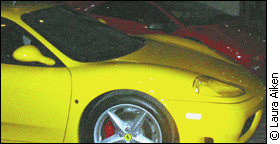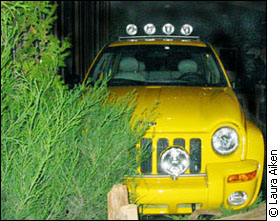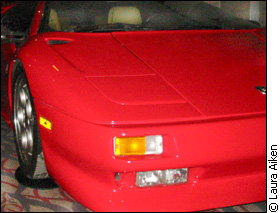Racecar driver Emerson Fitipaldi once said, "Outside my car I feel I am nothing; in it everything changes and I am virile master of the world and of destiny." I believed I was master of the universe when I drove my Monte Carlo Z34 off the dealer's lot and parked it in mine. It was true love in all its power, noise and pollution. The pollution I did not think much of at the time. But, as Bob Dylan wrote, the times, they are a changin'. The internal combustion engine has a challenger — an efficient, clean and quiet opponent. Fuel cells are proving to be a worthy competitor in the auto-industry race to develop clean technology. "I know fuel cells can do better than internal combustion engines. We just have to develop the technology," says Prof. Brant Peppley, a fuel cell research specialist at Kingston's Royal Military College. Canada is a distinguished player and major investor in a technology that has generated a lot of buzz. "Canada is a major innovator in this," says Tony Mazza, stack development engineer for the Toronto-based fuel cell assembling company Hydrogenics Corporation.
Fuel cell 101 Fuel cell 101 would be a pretty easy class to teach. Picture a fuel cell as a type of battery that uses an electrochemical process to create electricity instead of combustion. A fuel cell for automotive applications has four best friends: hydrogen, oxygen, a polymer electrolyte membrane (PEM) and a platinum catalyst. Hydrogen is that highly flammable friend that can be depended upon to create energy at any party, while air is that collected friend that neutralizes it. Hydrogen is pumped over one side of the cell while air is pumped over the other side. The platinum catalyst, the friend who encourages the highly flammable one into productive pursuits, causes the hydrogen to split into positive hydrogen ions and negatively charged electrons. The PEM, (the tough guy) acts like a bouncer in a bar, allowing only positive ions to pass through and sending the negatively charged electrons through an external circuit, creating electricity. When they come back around the loop, the electrons and the positive ions combine with air to create water, which runs out of the cell. This means that the only emissions from a fuel cell are heat and water. Essentially, the fuel cell borrows electrons from hydrogen, ships them off to create electricity and then brings them back and combines them with oxygen to form water. Fuel cell 102 Fuel cell 102 could be a class just on the challenges of getting this technology commercialized and on the road, so to speak. Two developments are needed. The price needs to come down and a standard method of fueling needs to be established. "There is no hydrogen infrastructure," says Richard James, spokesperson for General Motors Canada. In other words, there are no hydrogen gas stations to conveniently fuel up at nor are there practical industrialized ways to produce hydrogen. James says right now GM is using highly compressed liquid hydrogen stored in a tank. But Mazza says pure hydrogen will unlikely be the case when the vehicles begin to commercialize. "What may get us commercial is reformate [extracted] hydrogen from gasoline or diesel fuel." The car would have an onboard reformer that would extract hydrogen from another fuel such as gasoline, natural gas or methanol. The problem with a reformer is that it takes energy to extract the hydrogen, and that means a drop in efficiency, says Peppley. There would be carbon dioxide emissions, but it would still be far more environmentally friendly than the cars on the road now. Fuel cells are intrinsically a cleaner technology, with one of its major advantages being that it is most efficient when idling. For a society that is quite familiar with traffic jams, this is a bonus over current internal combustion engines that idle very poorly.
Hydrogen safety One big problem that Peppley says has been dealt with okay so far is the issue of hydrogen and safety. Companies, such as the U.S. based Thiokol Propulsion, develop and test hydrogen storage tanks abilities to withstand all sorts of abuses. The highly pressurized tanks get "shot at with bullets, thrown in fires and all the rest of it," says Peppley. However, the tanks are extremely expensive. The price of the technology is holding the whole show up. "If we could build it economically the lifetime would be about 1,000 hours...but we can make them last 10 to 15 thousand hours," says Peppley. The more platinum catalyst used, the better the product. Peppley also cites careful manufacturing as a factor in a fuel cell's lifespan. Bringing costs down is a bit of a paradox. The rules of the market economy say cost drops after a product is popularized and commercial, but fuel cell technology needs to get cheaper before it can get out there. Chickens and eggs "It's really a chicken and egg problem isn't it?" says Peppley
with a laugh. He adds that once it is proven that the cost can be brought
down, then the necessary investment will come. Mazza says electrochemical energy is very efficient, but he is constantly trying to improve the amount of power generated by the fuel cell. Although, he adds, the lower weight of an electric vehicle means that roughly half the horsepower is necessary to get the same speeds. Horsepower is measured as the voltage delivered to the motor multiplied by the current, which equals the power in watts. Watts is multiplied by 1,000 to get kilowatts. Multiply this number by 1.34 to get horsepower. For example, 130 hp is roughly 100 kW, says Mazza, adding that speed times are coming along nicely.
Tough enough? Mazza says Hydrogenics Corporation is aiming to take a fuel cell, with its precise and detailed parts, and make it rugged, durable and efficient. It has to be able to take the wear and tear of the road. Then there's the Canadian winter. "These cars have to deal with -40C weather, so there's the question of how do you start it, as freezing might damage the fuel cell," says Mazza. These barriers aside, Mazza still has faith in a fuel cell's commercial ability. "This is not a cheap technology at all," says Mazza. "But we are confident we can bring the cost down." This will have to happen for GM to meet their aim of pricing their fuel cell cars in a competitive market. According to James, GM's pricing will be based on the type of vehicle. For example, trucks would be priced competitively with other trucks and cars with other cars in a comparable market.
Designers gone wild Fuel cell technology has flung the doors wide open for innovative designers. The constraints of heavy engines and mechanical linkages are gone. What GM has come up with is an interchangeable body on a chassis that resembles a skateboard. The chassis of the Hy-Wire is only 28 centimetres. The car uses drive-by-wire technology, which completely alters any previous perceptions of how to drive a car. Drive-by-wire means driving using electronics instead of mechanics. James says he hopes the younger generation will have an easier time learning how to use the technology because using it is similar to playing a video game.
The Swedish company SKF developed the system GM chose. All major vehicle commands are executed through one consolidated hand-controlled unit. This includes steering, braking, changing gears, accelerating and clutch. The unit plugs into a single docking port of the chassis, meaning no need to design the car around mechanical linkages such as steering column and pedal assembly. James says the idea behind the design innovation is that you could swap the body of your car without buying a whole new vehicle. The body could be lifted off the chassis and replaced. Is a sports car no longer appropriate for your blooming family? Swap it for a van. The real question is when can you purchase one from your neighborhood dealer? "Honda is saying 2004, but that's your typically optimistic answer," says Peppley, who estimates 2008 as a target year for consumer purchase.
Going commercial However, he hinted that that the day could come much earlier due to "innovations" in the works. Peppley would not elaborate further as the research is unpublished. What may familiarize the public with the workings of fuel cells before their mass production in cars are solid oxide fuel cells, which use natural gas for power. Canadian companies, such as Global Thermoelectric Inc. and Fuel Cell Technologies Ltd., are working on stationary power plants and household furnaces. Imagine being able to provide all the heat and electricity for your home from a fuel cell powered furnace in your basement. Fuel cell technology has generated a lot of excitement, and investment. "It's amazing how many people are investing because they believe we really have to reduce pollution," says Peppley. A revolutionary relationship
Hopefully this belief will alter a very complex relationship people have with cars. According to a J.D. Power and Associates survey of car buying, 62 per cent say their car represents their personality. We put up with a lot from our vehicles, and they put up with a lot from us. I may have thought that I was the leader of the free world while bombing around in my Monte Carlo, but I soon found out my car was a high maintenance princess. After three years I had replaced nearly every part in it when it developed a severe case of the lemons. The engine actually nearly fell out of it. The ABS braking had to be disabled. On top of this, all that horsepower helped my license accrue several points for serious speeding offences; I accidentally burned holes in the leather seats with cigarettes and none of the door locks worked. To this day, three warning lights stay on all the time and no mechanic has been able to tell me why. The greater mystery is why I still stroke the rear spoiler every time I walk by it, conveniently forgetting what a pain in the butt it has been. While the technology and innovations happening in the auto industry may be constantly changing, it's likely that the bond I have with my car is here to stay. |
|


